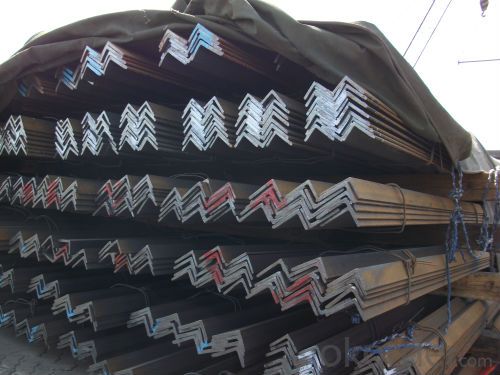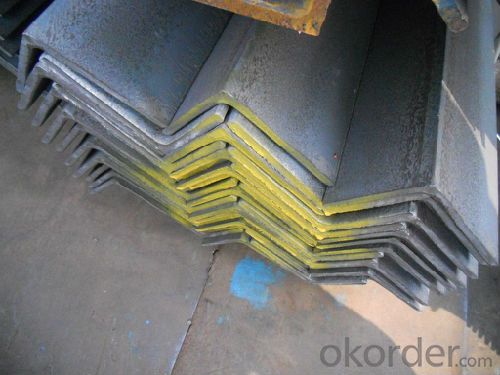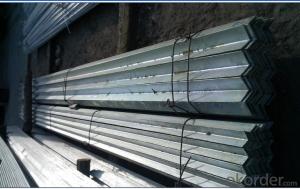Hot Rolled Steel Unequal Angle Bars
- Loading Port:
- Tianjin
- Payment Terms:
- TT or LC
- Min Order Qty:
- 100 m.t.
- Supply Capability:
- 20000 m.t./month
OKorder Service Pledge
OKorder Financial Service
You Might Also Like
OKorder is offering Hot Rolled Steel Unequal Angle Bars at great prices with worldwide shipping. Our supplier is a world-class manufacturer of steel, with our products utilized the world over. OKorder annually supplies products to African, South American and Asian markets. We provide quotations within 24 hours of receiving an inquiry and guarantee competitive prices.
Product Applications:
Hot Rolled Steel Unequal Angle Bars are ideal for structural applications and are widely used in the construction of buildings and bridges, and the manufacturing, petrochemical, and transportation industries
Product Advantages:
OKorder's Hot Rolled Steel Unequal Angle Bars are durable, strong, and wide variety of sizes.
Main Product Features:
· Premium quality
· Prompt delivery & seaworthy packing (30 days after receiving deposit)
· Can be recycled and reused
· Mill test certification
· Professional Service
· Competitive pricing
Product Specifications:
Manufacture: Hot rolled
Grade: Q195 – 235
Certificates: ISO, SGS, BV, CIQ
Length: 6m – 12m, as per customer request
Packaging: Export packing, nude packing, bundled
| UNEQUAL ANGLE STEEL | |||||
| size(mm) | a(mm) | a1(mm) | thickness(mm) | kg/m | length(m) |
| 75*50*5 | 75 | 50 | 5 | 4.808 | 6m,9m,12m |
| 75*50*6 | 75 | 50 | 6 | 5.699 | 6m,9m,12m |
| 75*50*8 | 75 | 50 | 8 | 7.431 | 6m,9m,12m |
| 100*75*7 | 100 | 75 | 7 | 9.34 | 6m,9m,12m |
| 100*75*8 | 100 | 75 | 8 | 10.6 | 6m,9m,12m |
| 100*75*9 | 100 | 75 | 9 | 11.8 | 6m,9m,12m |
| 100*75*10 | 100 | 75 | 10 | 13 | 6m,9m,12m |
| 100*75*12 | 100 | 75 | 12 | 15.4 | 6m,9m,12m |
| 125*75*7 | 125 | 75 | 7 | 10.7 | 6m,9m,12m |
| 125*75*8 | 125 | 75 | 8 | 12.2 | 6m,9m,12m |
| 125*75*9 | 125 | 75 | 9 | 13.6 | 6m,9m,12m |
| 125*75*10 | 125 | 75 | 10 | 15 | 6m,9m,12m |
| 125*75*12 | 125 | 75 | 12 | 17.8 | 6m,9m,12m |
| 150*90*8 | 150 | 90 | 8 | 14.7 | 6m,9m,12m |
| 150*90*9 | 150 | 90 | 9 | 16.4 | 6m,9m,12m |
| 150*90*10 | 150 | 90 | 10 | 18.2 | 6m,9m,12m |
| 150*90*12 | 150 | 90 | 12 | 21.6 | 6m,9m,12m |
| 200*100*10 | 200 | 100 | 10 | 23 | 6m,9m,12m |
| 200*100*12 | 200 | 100 | 12 | 27.62 | 6m,9m,12m |
| 200*100*15 | 200 | 100 | 15 | 34.04 | 6m,9m,12m |
FAQ:
Q1: Why buy Materials & Equipment from OKorder.com?
A1: All products offered byOKorder.com are carefully selected from China's most reliable manufacturing enterprises. Through its ISO certifications, OKorder.com adheres to the highest standards and a commitment to supply chain safety and customer satisfaction.
Q2: How do we guarantee the quality of our products?
A2: We have established an advanced quality management system which conducts strict quality tests at every step, from raw materials to the final product. At the same time, we provide extensive follow-up service assurances as required.
Q3: How many tons of steel products could be loaded in containers?
A3: Usually the steel products are delivered by bulk vessel because of the large quantity and the freight. However, there are no bulk vessel enter some seaports so that we have to deliver the cargo by containers. The 6m steel product can be loaded in 20FT container, but the quantity is changed according to the size, usually from 18tons to 25tons.
Images:


- Q:How are steel angles tested for quality and strength?
- Steel angles are tested for quality and strength through various methods to ensure they meet the required standards and specifications. One of the primary tests conducted on steel angles is the tensile test, which measures the material's resistance to breaking under tension. This test involves applying a gradually increasing load to a sample of the steel angle until it reaches its breaking point. The maximum load the angle can withstand is measured, and this provides critical information about its tensile strength. Another important test is the hardness test, which determines the steel angle's resistance to indentation. This test helps to assess the material's ability to withstand wear and tear, as well as its overall strength. Hardness is typically measured using the Rockwell or Brinell scales, where a harder material indicates higher strength. To ensure the steel angle's quality, it also undergoes visual inspections for any surface defects, such as cracks, uneven surfaces, or deformities. These inspections are conducted by trained professionals who carefully examine the angles for any imperfections that may compromise their structural integrity. In addition to these tests, steel angles may also undergo chemical composition analysis to verify that the material meets the required specifications. This analysis determines the percentage of various elements present in the steel, such as carbon, manganese, and sulfur, which directly impact the angle's strength and durability. Overall, steel angles are rigorously tested for quality and strength through a combination of physical, visual, and chemical tests. These tests ensure that the angles can withstand the intended loads and perform safely in various applications, providing confidence in their reliability and longevity.
- Q:Can steel angles be used in staircases?
- Yes, steel angles can be used in staircases. Steel angles are commonly used as structural elements in construction due to their strength and versatility. In staircases, steel angles can be used to provide support and stability to the steps and handrails. They are often used as stringers, which are the inclined structural members that support the treads and risers of the staircase. Steel angles can also be used to reinforce the connections between the treads and risers, ensuring the structural integrity of the staircase. Additionally, steel angles can be used as handrails or balusters, providing a secure and durable railing system. Overall, steel angles offer a reliable and cost-effective solution for constructing staircases that can withstand heavy loads and meet the necessary safety standards.
- Q:Can steel angles be used for framing or supporting partitions?
- Yes, steel angles can be used for framing or supporting partitions. Steel angles are commonly used in construction due to their strength and durability. They provide excellent support and stability, making them suitable for framing or supporting partitions in various structures.
- Q:How do steel angles compare to other structural materials, such as wood or concrete?
- Steel angles possess several advantages when compared to other structural materials such as wood or concrete. To begin with, the strength-to-weight ratio of steel angles is higher than that of wood or concrete. This implies that steel angles can bear heavier loads while being lighter in weight. This advantage becomes particularly crucial in construction projects where weight constraints must be taken into account. Furthermore, steel angles exhibit outstanding durability and resilience. Unlike wood, steel angles are impervious to rot, decay, or insect damage. They also possess a remarkable resistance to fire, making them a safer option for structural purposes. Concrete, on the contrary, is prone to cracking and deteriorating over time, while steel angles provide long-lasting structural integrity. What's more, steel angles offer greater design and construction versatility. They can be effortlessly shaped and fabricated to meet specific project requirements, enabling a more efficient utilization of materials. Additionally, steel angles are highly flexible, making them suitable for a variety of applications, including beams, columns, trusses, and frames. Moreover, steel angles demonstrate excellent recyclability. They can be easily melted down and reused, thereby reducing environmental impact and promoting sustainability. In contrast, wood and concrete are not as easily recyclable, often resulting in waste during demolition or renovation projects. Lastly, steel angles provide long-term cost-effectiveness. Although the initial cost of steel may be higher than that of wood or concrete, the durability and low maintenance requirements of steel angles make them a more economical choice over time. With minimal repairs and a longer lifespan, steel angles can save on future maintenance and replacement costs. In conclusion, steel angles possess numerous advantages when compared to other structural materials like wood or concrete. Their higher strength-to-weight ratio, durability, versatility, recyclability, and cost-effectiveness make them an excellent choice for a wide range of construction projects.
- Q:What are the tolerances for steel angles?
- The tolerances for steel angles can vary depending on the specific grade and manufacturing standards. However, in general, the tolerances for steel angles typically include dimensional tolerances such as length, width, and thickness. These tolerances ensure that the steel angles meet the required specifications and can be used effectively in various applications. For length, the tolerance usually ranges from ±1/8" to ±1/4", depending on the size and grade of the angle. This means that the actual length of the angle can vary within this range from the specified length. Similarly, for width, the tolerance can range from ±1/8" to ±1/4", ensuring that the actual width of the angle falls within this range from the specified width. In terms of thickness, the tolerance can vary depending on the manufacturing process and the grade of the steel angle. However, common tolerances for thickness can range from ±1/16" to ±1/8". This tolerance ensures that the actual thickness of the angle is within this range from the specified thickness. It is important to note that these tolerances are general guidelines and may vary depending on the specific requirements and standards set by manufacturers or industry regulations. Therefore, it is always recommended to refer to the product specifications or consult with the manufacturer for accurate and up-to-date information on tolerances for steel angles.
- Q:Where does channel steel use more? Where does angle iron use more?
- Hot rolled stainless steel ordinary channel (GB707-88) main use: ordinary channel steel, mainly used for building structures, vehicle manufacturing and other industrial structures, often with the use of i-beam.
- Q:Can steel angles be used in industrial or heavy-duty applications?
- Yes, steel angles can definitely be used in industrial or heavy-duty applications. Steel angles are known for their strength, durability, and versatility, making them suitable for a wide range of applications in various industries. They provide structural support, reinforcement, and stability in heavy-duty machinery, equipment, and infrastructure projects. Steel angles are commonly used in construction, manufacturing, engineering, and transportation industries, among others. They can be employed in applications such as frames, supports, bracings, platforms, beams, and trusses, where strength and load-bearing capabilities are crucial. Additionally, steel angles can withstand high temperatures, extreme weather conditions, and heavy loads, making them suitable for challenging industrial environments. Overall, steel angles are a reliable and efficient choice for industrial or heavy-duty applications due to their strength, durability, and adaptability.
- Q:How do steel angles compare to aluminum angles in terms of strength and durability?
- Steel angles are generally stronger and more durable than aluminum angles. Steel has a higher tensile strength and yield strength, meaning it can withstand greater forces and pressures without deforming or breaking. Additionally, steel is more resistant to corrosion and can maintain its structural integrity for longer periods compared to aluminum, which is more prone to oxidation and may weaken over time. Therefore, for applications requiring high strength and long-term durability, steel angles are a preferable choice over aluminum angles.
- Q:Can steel angles be used in framing?
- Indeed, framing can incorporate steel angles. In construction, steel angles are frequently employed to provide structural support and reinforcement. These angles possess adaptability, allowing for simple welding, bolting, or screwing together to construct frames suited for diverse purposes. By incorporating steel angles, structures gain both strength and stability, rendering them suitable for framing walls, ceilings, floors, and other structural elements. Moreover, steel angles are accessible in various sizes and thicknesses, permitting flexibility in design and construction. Ultimately, steel angles are a favored option in framing due to their enduring nature, versatility, and structural characteristics.
- Q:How do steel angles perform in terms of electrical conductivity?
- Steel angles have low electrical conductivity due to the high resistance of steel to the flow of electric current.
1. Manufacturer Overview |
|
|---|---|
| Location | |
| Year Established | |
| Annual Output Value | |
| Main Markets | |
| Company Certifications | |
2. Manufacturer Certificates |
|
|---|---|
| a) Certification Name | |
| Range | |
| Reference | |
| Validity Period | |
3. Manufacturer Capability |
|
|---|---|
| a)Trade Capacity | |
| Nearest Port | |
| Export Percentage | |
| No.of Employees in Trade Department | |
| Language Spoken: | |
| b)Factory Information | |
| Factory Size: | |
| No. of Production Lines | |
| Contract Manufacturing | |
| Product Price Range | |
Send your message to us
Hot Rolled Steel Unequal Angle Bars
- Loading Port:
- Tianjin
- Payment Terms:
- TT or LC
- Min Order Qty:
- 100 m.t.
- Supply Capability:
- 20000 m.t./month
OKorder Service Pledge
OKorder Financial Service
Similar products
New products
Hot products
Related keywords




























